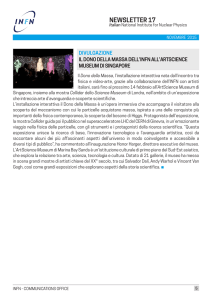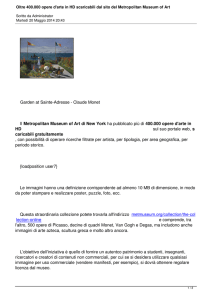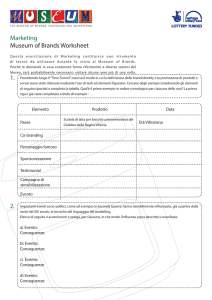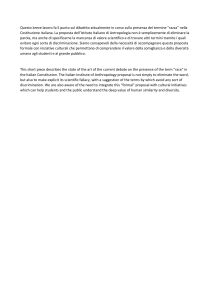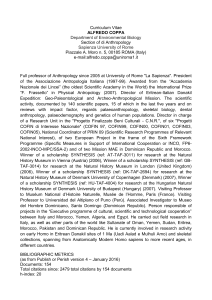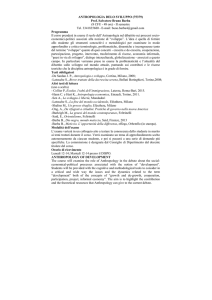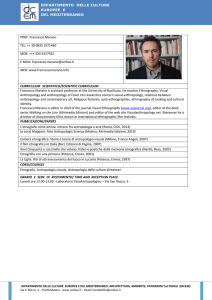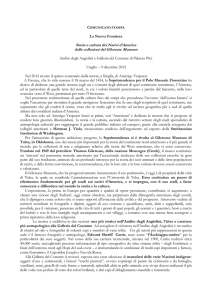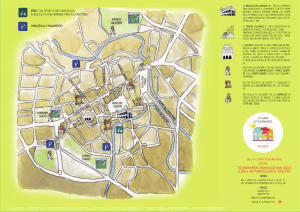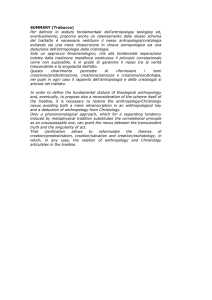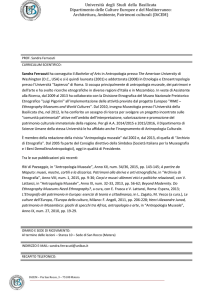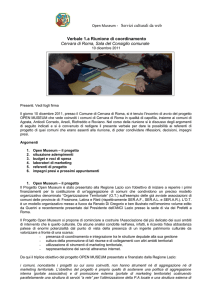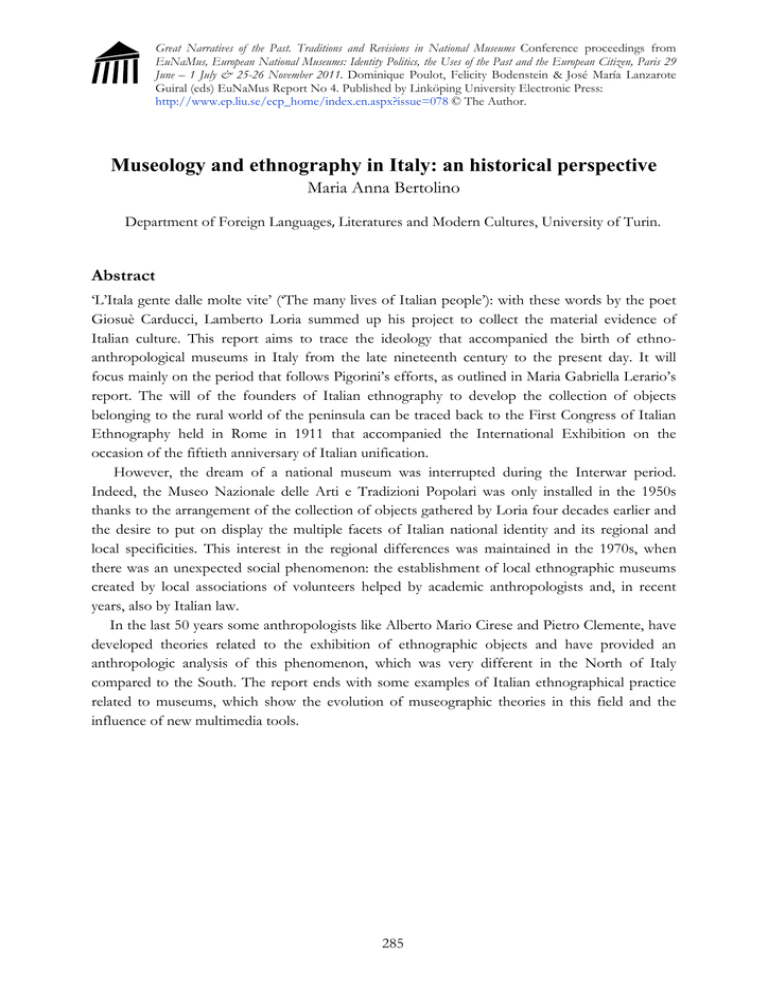
Great Narratives of the Past. Traditions and Revisions in National Museums Conference proceedings from
EuNaMus, European National Museums: Identity Politics, the Uses of the Past and the European Citizen, Paris 29
June – 1 July & 25-26 November 2011. Dominique Poulot, Felicity Bodenstein & José María Lanzarote
Guiral (eds) EuNaMus Report No 4. Published by Linköping University Electronic Press:
http://www.ep.liu.se/ecp_home/index.en.aspx?issue=078 © The Author.
Museology and ethnography in Italy: an historical perspective
Maria Anna Bertolino
Department of Foreign Languages,Literatures and Modern Cultures, University of Turin.
Abstract
‘L’Itala gente dalle molte vite’ (‘The many lives of Italian people’): with these words by the poet
Giosuè Carducci, Lamberto Loria summed up his project to collect the material evidence of
Italian culture. This report aims to trace the ideology that accompanied the birth of ethnoanthropological museums in Italy from the late nineteenth century to the present day. It will
focus mainly on the period that follows Pigorini’s efforts, as outlined in Maria Gabriella Lerario’s
report. The will of the founders of Italian ethnography to develop the collection of objects
belonging to the rural world of the peninsula can be traced back to the First Congress of Italian
Ethnography held in Rome in 1911 that accompanied the International Exhibition on the
occasion of the fiftieth anniversary of Italian unification.
However, the dream of a national museum was interrupted during the Interwar period.
Indeed, the Museo Nazionale delle Arti e Tradizioni Popolari was only installed in the 1950s
thanks to the arrangement of the collection of objects gathered by Loria four decades earlier and
the desire to put on display the multiple facets of Italian national identity and its regional and
local specificities. This interest in the regional differences was maintained in the 1970s, when
there was an unexpected social phenomenon: the establishment of local ethnographic museums
created by local associations of volunteers helped by academic anthropologists and, in recent
years, also by Italian law.
In the last 50 years some anthropologists like Alberto Mario Cirese and Pietro Clemente, have
developed theories related to the exhibition of ethnographic objects and have provided an
anthropologic analysis of this phenomenon, which was very different in the North of Italy
compared to the South. The report ends with some examples of Italian ethnographical practice
related to museums, which show the evolution of museographic theories in this field and the
influence of new multimedia tools.
285
Introduction
Italian ethnography and the institution of museum, developed since the eighteenth century, have
maintained close ties. They both arose from the collector’s desire to collect objects of distant
countries that became part of the Cabinet of curiosities as so-called mirabilia. The collection of
curiosities seems to have preceded the development of knowledge about the collections. In the
nineteenth century, the emerging discipline of anthropology, influenced by the positivist
paradigm developed methods of collecting objects, such as taxonomies and evolutionary
approach, so the museum became ‘the place to see the main phases of human development
represented and documented’ (Lattanzi 1994: 83). Objects and human remains from around the
world were collected during the expeditions of travellers since the sixteenth century. Those
objects contributed to the development of natural history museums in the Americas and in
Europe, therefore anthropology was linked to the development of the museum: the subject gave
legitimacy to scientific study of human cultures by positioning anthropology as a natural science
based on an experimental method.
The so-called ‘museum period’ (Jacknis 1985: 117) of anthropology is related to the figure of
Franz Boas (1858-1942), who worked at the American Museum of Natural History of New York
with a new method of collection, and built dioramas where the object was no longer considered
in isolation but its presence used to recreate the living part of the culture of non- Western
peoples. It was developed to attract a wider public not only composed of researchers but also the
middle-class and students of all levels (Jacknis 1985: 129-130).1
Otherwise, in Italy the relationship between anthropology and the museum developed later
because of the study of Folklore2 , which mainly took into account the immaterial aspects of
culture such as poetry, popular narratives or popular song and music. This was especially true
under the Italian process of cultural unification after 1860 in which these elements, despite their
distinctive characteristics that differentiate them from region to region, were seen in their unity as
a means to reconstruct the socio-historical plots and common roots of Italian inhabitants. In the
eighteenth century particular attention was paid to the antiquitates vulgaris (vernacular antiquities),
ie the concepts and practices of the people considered as consuetudines non laudabiles or errores
(unpraiseworthy habits or mistakes) (Cirese 1985: X). In this early period, the interest of Italian
folklorists focused on oral traditions, such as the production of songs and the popular narration,
and not on material culture. Besides this interest, in the late nineteenth century, physical
anthropology studies became relevant. This gave life to museums such as the Regio Museo
Nazionale Preistorico ed Etnografico in Rome founded by Luigi Pigorini (1842-1925) in 1875,
the museum Cesare Lombroso (1835-1909), established in 1876 in Turin, and the first university
museum of anthropology in Europe founded in Florence in 1869 by Paolo Mantegazza (18311910) to document the evolution of humans and the development of civilization. However, in all
these collections human remains or ethnological materials from other countries were partly
present to be compared with prehistoric collections.
At the beginning of the twentieth century, ethnography in Italy shifted, as can be seen in the
greater interest devoted to the material cultural aspects of Italian society, the focal point of the
Museo Etnografico Siciliano, directed by the physician Giuseppe Pitré (1841-1916) in 1910 in
Palermo. The most significant event was the creation in 1907 of a section of Italian ethnography
in the museum of Florence by the folklorist Lamberto Loria (1855-1913) and the physical
286
anthropologist Aldobranchino Mochi (1874-1931), both protagonists of the future constitution
of the Italian Society of Ethnography. Here the objects collected in Italy were compared with the
ethnological collections. In addition, the debate in the early twentieth century highlighted the
status of the ethnographic museum in relation to others as a political and social voice of a strong
national identity (Puccini 1985). Inspired by Paolo Mantegazza’s study titled Gli oggetti metamorfici
(1902), Aldobranchino Mochi recognized the importance of the philological reconstruction of the
object (in line with the tradition of the nineteenth century museology), seen as a valuable source
of information in the social and psychological life of peoples of which anthropology had to
provide an interpretation. Objects of Italian popular tradition were seen in the same perspective
as those so-called exotic culture (and considered as archaic) and they came to be considered as
documents for the reconstruction of the past (Mochi & Loria 1906).
In those years, there was a desire to develop programmed research on material culture: Italian
anthropologists felt that what had been done in the century before for intangible expressions of
culture such as songs and poetries should also be done now for material aspects. The idea that
Objects could be used to show how the differences of Italian people from the North to the
South developed throughout the centuries but also to discover a Unity in the diversity as the
basis on which to built the Nation. So in the 1911 an ethnographic exhibition was organised by
Lamberto Loria during the International Exposition of Rome that celebrated the fiftieth
anniversary of Italian unification.
The exhibition was the first step of a bigger project: the establishment of a national museum
of ethnography. After five years of research a huge collection of objects had been amassed; Loria
had expressed his intention to collect all of the most characteristic objects belonging to rural
populations such as cloths, tools, instruments, furnishings and fittings, artefacts because:
the objects used and manufactured by ordinary people must be collected and studied as the
mental products of the folk activity (Loria Mochi, 1906: p. 17).
In addition to the activity of collecting objects for the museum, the material life of traditional
rural society was examined with careful observation in fieldwork by using instruments such as
photography. Social life and ritual aspects were left outside the picture. This ethnographic
approach was conceived as a safeguard operation antelitteram because the protagonists knew they
had to work quickly to save the testimony of an endangered world:
the analysis of our people should attract us more than any other ethnographic issue, because
it is a more familiar subject and of a practical utility. We should collect from everywhere
what remains of the documents related to the typical local folk reality, if we do not want to
risk having only altered remnants (Loria Mochi, 1906: p. 14).
The exhibition was inaugurated in April and it had all the characteristics of an Open-air
museum, indeed it was described as such in contemporary accounts. Several reconstructions of
sites and places of work and of local crafts, traditional houses, clothes and tools were shown to
create an Italian identity and therefore a united people. However, they also demonstrated the
regional differences of the Belpaese as in the verses of the Italian poet Giosué Carducci ‘L’Itala
gente dalle molte vite’ (‘The many lives of Italian people’).3
The intention of the organisers was to allow each inhabitant of Italy to find a small piece of
his own land in Rome. This was to promote a sense of belonging in the hearts of the people. The
climate of the exhibition was strongly imbued with symbolic patriotism. In addition, the
287
readability of the exhibition made it the most visited event within the International Exhibition
(Puccini, 2005: 156). However, the purpose was scientific research as can be seen in the display’s
way of following an evolutionary logic that presented the material as an archaic social form. The
First Congress that took place in October laid the foundation for a reflection on the status of
research in Italian ethnography, as well as its representation in museums.4
Loria’s programme gave the museum a central role in the nascent discipline of Italian
ethnography allowing it to become a tool for understanding of the cultural history of the nation
as a whole. Discussions took place as to the structure of the exhibition: there were those who
defended the organisation according to geographical areas where the object testified the
specificity of local culture whilst others argued for a comparative display as the better method to
show the continuity of cultural aspects.
Mochi became a spokesperson for the museum’s educational role, while Francesco
Baldasseroni (1878-1923), a historian collaborator of Loria, introduced some questions of
modern museology, such as the reflection on the loss of vitality of the object and its fossilization
when removed from its original context and placed in a museum. The museological organization
into categories of objects, allowed the historian to dynamically analyse them, comparing the
morphologic features and functions. However, the establishment of a national museum, whose
purpose was to expose the material culture of a unified Italian people, to be an imaginary unifying
narrative about the nation and the summary of all regional museums, was halted by the death of
Loria in 1931. The museum was eventually to be opened in the 1950s.
Anthropology in the modern museum
The four decades that separate the two events were full of political, social and cultural changes.
The ideology of Fascism had used ethnology to contribute to the promotion of its populist
rhetoric and staged an archaic and pure peasant world. The museum was born after this period,
in 1956 at the initiative of Paolo Toschi (1893-1974), already editor of the collection inherited
from Loria, of which he had catalogued years earlier.
The denomination ‘ethnographic museum’ was changed to Museo Nazionale delle Arti e
Tradizioni Popolari, because the term ethnography did not comply with scientific criteria that had
inspired the Museum’s organisation, where only the material related to the artistic and traditional
folk products of Italy were to be exhibited. Moreover, there was an increasing interest in folk art,
which in the nineteenth century had already been considered from a romantic point of view, and
an increase in the use of expressions such as ‘folk traditions’, also in the fascist rhetoric.
Alongside these reasons, the influence that had caused the separation of the Musée
d’Ethnographie from the Musée de l’Homme in Paris, changing the name into Musée des Arts et
Traditions Populaires on a proposal of the museographer George Henry Riviére also played an
important role. However, even if a National museum on ethnography is today an important focal
point for many activities in Italy, and the main institution for anthropology (IDEA, Istituto
centrale per la demoetnoantropologia), it is important to remember that the idea of a presenting a
national museography, as conceived by the founders, has been definitely abandoned to highlight
the multiple regional and local identities of the Italians.
It was only in 1964, that the Commission Franceschini recognized a legal definition of
national cultural heritage.5 At the same time Tullio Tentori (1920-2003), director from 1956 to
288
1972, and chief of the National museum from 1968, defined the following tasks and functions:
collection of the anthropologic heritage in Italy, divulgation activities, consulting services for the
State and public authorities, analyses and research activities, training, and updating activities for
the internal and external administrative staff. Yet, even after the 1960s ethnographic heritage was
not legally recognised, and this caused a lack in its protection and conservation (Mariotti 1999:
105).
Official recognition came as a result of the restructuring of the Ministero per i Beni e le Attività
Culturali (MiBAC) in 1998 (Dlgs 368/1998), with the creation of a Superintendence for the
tangible and intangible heritage that takes care of archaeological, historical, artistic and
architectural heritage as represented in the Museo Nazionale di Arti e Tradizioni Popolari. In 2004 the
Codice dei Beni culturali e del paesaggio (Dlgs 42/2004) was published setting out criteria for the
recognition of this type of property. Finally the Instituto Centrale per la Demoetnoantropologia (Decreto
del Presidente della Repubblica del 26 November 2007 n. 233) was created in 2007. However, a
significant commitment came from the Regions 6 that have encouraged the development of
Centres for Documentation in collaboration with Universities (Bravo & Tucci 2006: 82). The
academic interest towards folk art has increased since the 1970s, when a movement of
rediscovery of local culture emerged.
From an historical point of view the social-cultural context after the war in Italy was
particularly complex. On one hand the north was more and more urbanised and there was a
strong economical development, on the other hand the south was marginalised, the style of life
was still very traditional and there was a high rate of immigration to the north. Therefore the
phenomenon of abandonment of traditional culture was much more pronounced in the
industrialised regions and explaining the earlier creation of local museums in northern Italy.
Actually, since the 1950s people have been leaving the countryside and new generations have
been neglected rural culture, considered as backward, whilst the conditions of life in the city were
considered better and industry was seen as a more secure jobs sector. The elders stayed in the
countryside, but the process of cultural transmission and other agro-pastoral aspects were lost. It
seemed as though the economical boom had made all the rituals, usages of the traditional
agricultural calendar disappear, to make room for the new models of mass culture society.
However, since the 1970s people started to be interested in the conditions of life in the past.
Even if the urbanisation and industrialisation process did not stop, such phenomena as the
energy crisis, pollution, and high unemployment rates, brought people back to the past (Bonato
2006: 21) restoring rituals and festivals (the immaterial aspect of the culture) and leading to the
collection of objects that belonged to rural culture.
Living in a complicated society led to by a ‘desire of the past’ from the youngsters who,
committed to an ‘ethnography of recovery’ (Clemente & Rossi 1999: 20), created local museums
to display the traditional lifestyle of their parents and grandparents through its material culture
and its changes in industrial society. In this case, the museography that developed has been
described as ‘spontaneous’ (Bravo & Tucci 2006: 60-67), because it is often linked to the activity
of communities. This movement has enabled the development of museums strongly linked to the
local residents of a territory. They draw on the Open-air model of museums established at the
end of the nineteenth century in Northern Europe with the aim of preserving elements of the
rural environment, and of creating a reality closer in time and space, much like the Ecomuseums
289
established in France in the 1970s with the aim of giving a diachronic vision of territorial change
connected to the local community.
The local ethnographic museum is a cultural project with specific connotations and
particularities: first of all a founder, that could be a single person or local group naturally
established and then transformed into an association, who create a group of local intellectuals, as
organiser and defenders of this culture. (Bravo, 2006, p. 18) The museum gains its lively
personality from their experience. Among those promoters of culture who have contributed to
the establishment of important museums, there are Ettore Guatelli, founder of the housemuseum that bears his name in Ozzano Taro (Emilia-Romagna), and Giuseppe Šebesta, who
establish the Museo degli Usi e Costumi della Gente Trentina in San Michele all’Adige (Trentino Alto
Adige). These museums were established on erghologic (related to the ‘old profession’) and
georgologic (‘the rural civilisation’) paradigms; the majority of the local ethnographic museums
recalls pre-industrial manual work and are set into a wider context of etereogenic folk interests
such as the creative revisitation of the traditional technologies and traditions, a phenomenon
known as folk revival which includes singing, festivals and the Carnival (Bravo 2006: 17). Lastly,
the language of these museums came from a reflection on the nature of time and from the
nostalgia for what is an irrecoverable past.
At university level, such bottom-up phenomenon were studied by academic anthropologists
who took interest in Italian traditions thanks to the rediscovery of Antonio Gramsci’s theories on
the hegemonic culture (see Cirese 1973). This allowed them to formulate an applied anthropology
referring to the creation of participating museums and the interpretation of the objects on display
(Turci 1999).7 Through these developments, folk culture started to be analysed as a science of
‘cultural gradients’ resulting from the difference between the dominant culture and the
subordinate ones. Gramsci (1891-1937) believed that the subordinate social classes that define
the people have a culture which reflects social diversity (different conceptions, costumes and
uses, religion and morality). The consciousness of the social class in the context of the 1960s, has
led experts Alberto Mario Cirese (1921-2011) to concentrate on the phenomenon of the
ethnographic museums establishment, which analyses the subordinate class culture of the agropastoral world, as a result of a ‘consciousness of the price paid’ that refers to the birth of
industrial society and post industrial, urban life that in a short time to the loss of a traditional
style of life. Both Alberto Mario Cirese and Pietro Clemente elaborated museological theories
that still condition the organisation of local museums. They privilege a central vision of the
museum as an anthropological discourse on the issue of representation and on the function of
the object as a document of different social contexts.
Alberto Mario Cirese was the protagonist of this new interest and also the founder of new
museum studies in anthropology. He built a bridge with the past by adopting the arguments
advanced in the Congress of 1911, referring to the passage of the object in historical document
when it is moved from its context of use to the museum. Through his theory, that considered the
museum as a meta-language (Cirese 1977), he addressed the problem of the object that loses its
original use inducing a loss of vitality and becoming something dead. The museologist’s task is to
make the ethnographic museum a vital place because, by the characteristics of what it presents, it
must recreate for the visitor life as it is beyond the museum: it means reconstructing social and
functional contexts of use for the ethnographic object but also the comparison of the
290
morphological characters between objects of the same provenance or from other contexts. In
Cirese’s view, the museum continues to be a place of scientific research where exposure coincides
with the most faithful representation of knowledge (Cirese 1977: 44).
In turn, Pietro Clemente theorized about, and subsequently put into practice, a method of
display based on the evocative dimension of the object: meaning that the museum was no longer
uniquely a place of scientific research but also a place where objects are at the centre of the
exhibition. The visitor is then driven in the first person with his memories, his imagination and
his life experience (Clemente 1996). What becomes important is the scenography that binds
objects in the network of a social and cultural system: the display and the museum became the
translation of scientific conventions in different languages that use all human senses.
Regional Outlook
The current study of ethnographic museums in Italy observes the strong local and regional
identity of these institutions and the repetitive character of their collections, with a narrative
based in particular on the peasant’s work and traditional lifestyles.
The first analysis of ethnographic museums dates back to the 1985 (in Togni, Forni and
Pisani, 1997: 11), with a recording of 150 institutions; a census led in the 1991 and reported by
the Jalla (2003: 42-47). Out of 3311 recorded museums, the ethnographic museums made up
nearly four hundred, a seventh of the total (Bravo 2006: 58). In the 1990s the number increased,
confirming an unequal territorial distribution that showed the north ahead of the centre or south
Italy: in 1997, in Piedmont there were 70 museums, a number that rose to 188 in 2007 (Bonato
2007: 64). The third edition of Il Patrimonio Museale Antropologico, Itinerari nelle Regioni Italiane,
Riflessioni e Prospettive was promoted by the Ministry (MiBAC), the other two editions published in
2002 and 2004, had already recorded the increase of ethnographic museums: there were 1300
museums in Italy in 2009. The data from the census carried out during those years, shows the
diffusion across the territory of museums, often private or local institutions run by volunteers.
Apart from major institutions such as the already mentioned Museo Nazionali di Arti e
Tradizioni Popolari we find regional museums that occupy an important place for research, such
as the Museo degli Usi e Costumi della Gente Trentina, in the region of Trentino- Alto Adige, the
Museo della Civiltà Contadina di San Marino di Bentivoglio and the Museo degli Usi e Costumi
della Gente di Romagna, both in Emilia Romagna: the latter two were founded in the 1970s, and
promoted those popular movements referred to above: the material testimony to the past is
saved from time only by putting it into a museum.
The work of Giuseppe Šebesta (1919-2005) is related to the Museo degli Usi e Costumi della
Gente Trentina. He was an ethnographer, a writer and a painter (Kezich 1994: 71). He began a
collection of objects in 1966, and only two years later he opened his museum dedicated to his
region. By analysing this operation there is a strong contrast with the views that currently
dominate in the anthropology of museum work. In fact, his work is the result of a holistic
perspective on alpine culture that aims to present the totality of social and historical facts: Šebesta
had more familiarity with the positivist studies and the tradition of evolutionary diffusionism, two
approaches that had already been dropped from museology since the Second World War.
The ethnographic museum becomes an offshoot of the natural history museum: the primacy
is given to material, to the technologies and to handicraft in view of a traditional museography of
291
the daily work of peasants, based on the reconstruction of the major processes and technical
evolution, and on a vision of the museum as a research laboratory of the historical and
technological territory (Clemente 1999: 16). In the course of his work, Šebesta favoured a display
focused on specific technological networks, beyond a local approach, breaking with the Italian
anthropology museum devoted to the agricultural cycle and to the calendar; this is so because the
material culture of mountain people is inserted in the great currents of the circulation of cultural
traits in a transalpine perspective and with a comparative analysis where he tries to trace its
proximity with prehistoric man (Kezich 1994: 75).
Although rearranged, the museum still deliberately retains traces of its founder’s work. It is
currently one of the most lively in the panorama of Italian ethnographic museum, a reference
point for studies in the Alpine area and for the safekeeping of anthropological collections. A
Permanent Seminar on Alpine Ethnography (SPEA) is held each year and in July 2011 a summer
school was inaugurated on museological and ethnographic issues.
The museum in San Marino di Bentivoglio (province of Bologna) was founded by a group of
citizens called ‘Gruppo della Stadura’ in 1968. Initially, this group was devoted to the
organization of meetings and debates on the rural world. Then, through their participation in
festivals, carnivals and markets, a large number of objects, tools and materials of traditional rural
life were gathered. Thanks to the intervention of the public authorities and with the University
the museum was established two years later and it is still one of the best examples of spontaneous
museography (Papa 1994: 551-552). Another example of this is the Museo degli Usi e Costumi della
Gente di Romagna founded in the 1980s under the supervision of Giuseppe Šebesta in which the
collections were made by researches in the field ten years earlier.
Today, anthropology thinks back on several attempts to found a new conception of the
museum as a place for the intersection between tangible and intangible heritage as explained in
the definition of ICOM (International Council of Museum):
a museum is a non-profit, permanent institution in the service of society and its
development, open to the public, which acquires, conserves, researches, communicates and
exhibits the tangible and intangible heritage of humanity and its environment for the
purposes of education, study and enjoyment. (Statutes art.3 para.1).
One example to illustrate this might be the interactive installation Montagna in Movimento,
located in the fortress of Vinadio in Piedmont and opened in 2007. The exhibition will provide
an experience of the Maritimes Alps, once part of the Occitania region, and it tries to bear witness
to the vitality of the mountain world as something that is not immutable, as it might be imagined,
but is a dynamic world of cultural exchange. In this case the museum’s work can be compared to
that of a scenographer. Indeed nothing is set in advance and visitors can choose the direction of
their visit and also interact with objects and multimedia products. Each question related to
traditional knowledge, traditional calendar rituals, or material culture is explained with the help of
sound recordings and movies. This kind of museum is the result of research on oral data and the
participation of the ethnographer in the restitution of a life experience.
We have seen that one of the issues concerning the work of the anthropologist in the
ethnographic museum is the field research for the constitution of a corpus of oral sources. These
constitute the major vector of social communication and transmission of those cultural traits of
the societies best represented in Italian ethnographic museum (Gandolfi 1994: 67). Through oral
292
sources it is possible to reconstruct the context and the dynamics of the social layer to which the
objects belonged: they provide information on technical and ergonomic aspects of the objects,
whose use is also connected to rituals, songs, tales, proverbs and stories.
The use of this type of data and its placing in the museum historicize the artifacts and cultural
expressions by returning to a diachronic approach and introduce a communication between past
and present. It follows that this methodology transformed the anthropology of museum into a
science engage, the primary function of cultural transmission of lived experience (Gandolfi 1994:
68).
The emphasis placed on the use of oral sources allows the museum to go beyond the object
and the diversity of its forms of documentation for the representation of the past. It tries to build
installations and exhibitions based on ethnographic research based on the collection and the
valorization of local oral sources and their translation into museum language: operations that can
result only from a deep understanding of the reality in which anthropologists work. This kind of
museum privileges the discourse at the expense of object, so the museum becomes a real space
for ‘writing ethnography’.
Conclusion
Italian anthropology in museum over the last thirty years has been through a series of experiences
dictated by several goals, including the collection, preservation, cataloguing, and the exposition
criteria that go beyond collecting and aestheticism. The new communication of an ethnographic
museum seems to be problematic because it has a didactic character, aimed at training and
educating the public, but mainly because the museums were involved in the recent revolution of
communication technology that offers the possibility of new experiments by the authors of
exhibitions and the visiting public.
Multimedia products, as hypertext, are characterized by non-linearity, by a writing and a
reading that is non-sequential and that branches off in different directions, that is multisensory,
combining different forms of learning and that is by nature interactive. The museological
multimedia approach combines many types of communication: written pages of illustration of the
argument as tables, cards, analysis, bibliographies, still and moving images and sound that
reproduces music, songs, stories and interviews (Bravo 2004: 51). Multimedia dispositions can
evoke the original context of objects exposed in the museum and constitute the foundation for
an online museum system that allows network users to access the cultural content of local interest
which, by their nature, are intended to be enjoyed by a few. The new technologies can therefore
expand the knowledge and the potential spread of material culture and folk traditions of a given
context but also preserve and comparatively analyse cultural heritage.
In their work, anthropologists look at various policies that support the local building of a
shared heritage. In addition, they have an active role in the foundation of new museums and new
collections based on field research and using a qualitative methodology and participatory
planning by means of the involvement of local population. In this sense, anthropological sciences
are increasingly called upon to aid in this participatory planning as mediation between different
cultural contexts on the same territory as a transcultural approach.
In fact, the regional and local outlook persists in the request and in the preparation of new
museums that demonstrate the plural inflections of the Italian identity. As we have seen
293
previously, since the 60s the terms "arts and traditions" or "the people", declined territorially at
the regional borders, have been favoured (besides the already mentioned museums we can take
the example of the Museo delle Genti d’Abruzzo). Now, with the evolution of this institution and the
emergence of the eco-museum, the salient features of the museum narratives pass through the
local crafts, the landscape or the traditional crops, which become new elements on which to
invest in view of capitalizing on local cultures. These elements become the symbol of new
identities, and the museum becomes their guardian and informant.
Notes
1
2
3
4
5
6
7
For an overview of the developments of museological theories in anthropology also see Stocking (1985).
Folk is used as a term in the study of folk traditions while ethnology is the study of extra-European cultures, a
distinction created by the anthropologic sciences in Italian historiography.
The verse is part of the ode ‘La chiesa di Polenta’ in the collection of poetries Rime e Ritmi (1899).
One can find discussions on the Lares journal (published since 1912 until 1915 and directed by Lamberto Loria
and then Fracesco Novati).
Established with the Legge del 26 aprile 1964, n. 310, it recognizes cultural property as a value of civilization.
In the Italian law, Regions are responsible for the actions of promotion and preservation, while the State has
the task of protection (Dlgs. 42/2004 art. 7).
The opening of the museum by anthropologists has been made possible by the establishment of the Section of
Anthropology Museum at the Associazione Italiana per le Scienze EtnoAntropologiche (Aisea), while a
contribution to the promotion of various jobs linked to anthropological museology was made by the Società
Italiana per la Museologia e i Beni Demoetnoantropologici (SIMBDEA).
Bibliography
Becucci, S. (2007) ‘Quando l'antropologo gestisce il museo: da negazione a modello’,
Etnoantropologia on line, Atti del IX Congresso AISEA, n. 1/2007: pp.38–43.
Avalaible:
<http://digidownload.libero.it/aisea/atti_2004/etnoantropologia%20numero%201_
2007.pdf>, (accessed 2 October 2011).
Bellato E. (2009), ‘La dolce seduzione. Un museo-non museo senza oggetti’ , in Porcellana
V. & Sibilla P., Alpi in scena. Le minoranze linguistiche e i loro musei in Piemonte e Valle
d'Aosta, Torino: Daniela Piazza Editore.
Bertolino, M.A. (2011) ‘Museo-grafare le culture locali. Un caso di studio: la sezione del
legno del Museo Etnografico di Pinerolo’, Antrocom Online Journal if Anthropology, vol.
7, supp. Al n. 1: pp.17–25.
Bertolino, M.A. (2012) ‘La ricerca sul campo nella tradizione italiana delel scienze
demoetnoantropologiche’, in Kottak C.P., Antropologia Culturale, Milano: McGrawHill: pp.79–82.
Bonato, L. (2006), Tutti in festa: antropologia della cerimonialità, Milano: FrancoAngeli.
–––– (2007), ‘Musei e feste: mappe a confronto’, Etnoantropologia on line, Atti del IX
Congresso AISEA: n. 1/2007, pp. 64–73. Available:
<http://digidownload.libero.it/aisea/atti_2004/etnoantropologia%20numero%201_
2007.pdf>, (accessed 2 October 2011).
Bravo G. L. (2004), ‘Far parlare il museo’ in Bravo, G.L., Cafuri, R. (eds), Comunicare il
passato: appunti di metodo per una didattica museale sulle culture locali, Torino: Provincia di
Torino: pp. 31–52.
294
–––– (2005), La complessità della tradizione, Milano: FrancoAngeli.
–––– (ed.) (2001) Tradizioni nel presente. Musei feste fonti, Torino: Omega.
Bravo, G. L. & Tucci, R. (2006) I beni culturali demoetnoantropologici, Roma: Carocci.
Carducci, G. (1899) Rime e Ritmi, Bologna: Zanichelli. Available:
<http://www.letteraturaitaliana.net/pdf/Volume_9/t215.pdf>, (accessed 20
September 2011).
Cirese, A. M. (1973), Cultura egemonica e culture subalterne. Rassegna degli studi sul mondo
popolare tradizionale, 2. ed. accresciuta. Palermo: Palumbo.
–––– (1977) Oggetti, segni, musei. Sulle tradizioni contadine, Torino: Einaudi.
–––– (1985) ‘Sulla storiografia demo-etno-antropologica italiana’, in Clemente, P., et al.
(1985) L'antropologia italiana, un secolo di storia, Bari: Laterza.
Clemente, P. (1996) Graffiti di museografia antropologica italiana, Siena: Protagon.
Clemente, P. & Rossi, E. (1999) Il terzo principio della museografia. Antropologia, contadini,
musei, Roma: Carocci.
Clemente, P. & Meoni, M.L. & Squillaciotti, M. (1976) Il dibattito sul folklore in Italia,
Milano: Edizioni di Cultura Popolare.
Cordero M. (2009), ‘Montagna in movimento nel Forte di Vinadio, Valle Stura. Un
cantiere per il futuro’, in Porcellana V. & Sibilla P., Alpi in scena. Le minoranze
linguistiche e i loro musei in Piemonte e Valle d'Aosta, Torino: Daniela Piazza Editore.
De Risi, L. (1995) ‘Il carteggio Mochi-Loria. Primo bilancio del contributo di
Aldobrandino Mochi all'etnografia Italiana’, La Ricerca Folklorica, n. 32: 105–109.
Di Vito, A. (2007) ‘Patrimoni contesi, fra antropologia teorica e antropologia applicata’,
Etnoantropologia on line, Atti del IX Congresso AISEA, n. 1/2007: pp.112–18.
Available
<http://digidownload.libero.it/aisea/atti_2004/etnoantropologia%20numero%201_
2007.pdf>, (accessed 2 October 2011).
Gandolfi A. (1994), ‘Fonti orali e didattica museale’, in Kezich G. e Turci M. (a cura di),
Antropologia Museale. Caratteri, rappresentazioni e progetti dei musei antropologici, demologici
ed etnografici. Atti del 1° Seminario Nazionale di Antropologia Museale (Roma-San Michele
all'Adige, 1993), in “SM. Annali di San Michele”, n. 7:
Jacknis I. (1985), Franz Boas e le mostre. Sui liniti del metodo museale in antropologia, in
Stocking jr., G.W. (ed.) (2000), Gli oggetti e gli altri. Saggi sui musei e sulla cultura
materiale, Roma, EI: pp. 117–154 (orig. Objects and others : essays on museum and
material culture, Madison: University of Wisconsin Press, 1985).
Jalla D. (2003), Il museo contemporaneo. Introduzione al nuovo sistema museale italiano, Torino:
UTET.
Kezich G. (1994), ‘Il Museo degli usi e costumi della gente trentina e l'opera di Giuseppe
Šebesta’, in Kezich G. e Turci M. (a cura di), Antropologia Museale. Caratteri,
rappresentazioni e progetti dei musei antropologici, demologici ed etnografici. Atti del 1°
Seminario Nazionale di Antropologia Museale (Roma-San Michele all'Adige, 1993), in “SM.
Annali di San Michele”, n. 7: 71–80.
Lattanzi, V. (1994) ‘Il museo etnografico nelle derive della modernità. Appunti di critica
antropologico-museale’, in G. Kezich & m. Turci (1994) Antropologia Museale.
Caratteri, rappresentazioni e progetti dei musei antropologici, demologici ed etnografici. Atti del
1° Seminario Nazionale di Antropologia Museale (Roma-San Michele all'Adige, 1993),
numero unico di “S.M. Annali di San Michele”, n. 7: 81–92.
295
–––– (1999) ‘Per un'antropologia del museo contemporaneo’, in Turci M. (1999)
Antropologia museale, n. 39: 29–40.
Lombardozzi, A. (1994) ‘Metodologia della ricerca e progetto museale in Lamberto Loria’,
in G. Kezich & M. Turci, Antropologia Museale. Caratteri, rappresentazioni e progetti dei
musei antropologici, demologici ed etnografici. Atti del 1° Seminario Nazionale di Antropologia
Museale (Roma-San Michele all'Adige, 1993), numero unico di “S.M. Annali di San
Michele”, n. 7: 109–115.
Loria, L. (1907) Com’è sorto il museo di Etnografia Italiana in Firenze, Comunicazione al VI
Congresso Geografico Italiano: Firenze.
Loria, L. & Mochi, A. (1906) Il Museo d'Etnografia Italiana in Firenze. Sulla raccolta di
materiali per l'Etnografia Italiana, Milano: Marucelli.
Maffi, I. (ed) (2006) ‘Il Patrimonio Culturale’, in Antropologia, 6, n. 7, Roma: Meltemi.
Mariotti, M. (1999) ‘Antropologia museale. I luoghi del dibattito della formazione e del
mestiere’, in Turci, M. (1999) Antropologia museale, n. 39, pp.101–16.
Papa, C.(1994) ‘Le travail entre démologie, muséographie et culture matérielle’, in Italia,
regards d’anthropologues italiens, Ethnologie française, XXV, n. 3: 549– 65.
Porcellana, V.(2009) ‘Il museo partecipato. Il caso di Gressoney- La- Trinité (Ao) ’, in
Porcellana, V. & Sibilla P. (a cura di), Alpi in scena. Le minoranze linguistiche e i loro
musei in Piemonte e Valle d’Aosta, Torino: Daniela Piazza Editore, pp. 53–58.
Puccini, S. (1985) ‘Evoluzionismo e positivismo nell’antropologia italiana (1869–1911) ’,
in Clemente, P., et al. (1985) L'antropologia italiana, un secolo di storia, Bari:
Laterza.
–––– (2005) L' itala gente dalle molte vite. Lamberto Loria e la mostra di etnografia italiana del
1911, Roma: Meltemi.
Stocking jr., G.W. (ed) (2000), Gli oggetti e gli altri. Saggi sui musei e sulla cultura
materiale, Roma, EI (orig. Objects and others : essays on museum and material culture,
Madison: University of Wisconsin Press, 1985).
296

